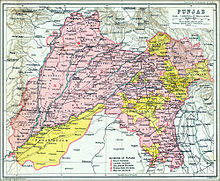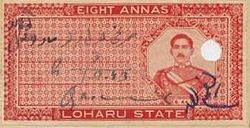
Bahawalpur is a city in the Punjab province of Pakistan. It is one of the ten largest cities of Pakistan and 6th most populous city of Punjab. Bahawalpur is the capital of Bahawalpur Division.

Bahawalpur was a princely state in subsidiary alliance with British Raj and later Dominion of Pakistan, that was a part of the Punjab States Agency. The state covered an area of 45,911 km2 (17,726 sq mi) and had a population of 1,341,209 in 1941. The capital of the state was the town of Bahawalpur.

Malerkotla is a city and the district headquarters of Malerkotla district in the Indian state of Punjab. It served as the seat of the eponymous princely state during the British Raj. The state acceded to the union of India in 1947 and was merged with other nearby princely states to form the Patiala and East Punjab States Union (PEPSU).

Jhang is the capital city of Jhang District in the central portion of the province of Punjab, Pakistan. Situated on the east bank of the Chenab river, it is the 18th largest city of Pakistan by population.

Loharu is a city, municipal committee and assembly constituency, near Bhiwani City in the Bhiwani district of the Indian state of Haryana. It is the administrative headquarters of one of the four administrative sub-divisions of the district and covers 119 villages. It is also a railway junction station.
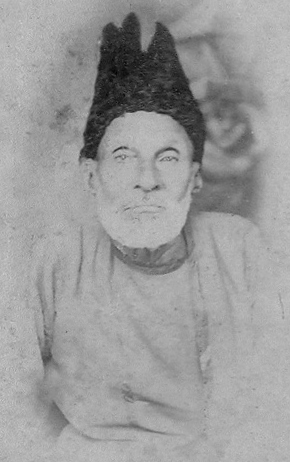
Mirza Beg Asadullah Khan (1797–1869), also known as Mirza Ghalib, was an Indian poet. He was popularly known by the pen names Ghalib and Asad. His honorific was Dabir-ul-Mulk, Najm-ud-Daula. During his lifetime, the already declining Mughal Empire was eclipsed and displaced by the British East India Company rule and finally deposed following the defeat of the Indian Rebellion of 1857; these are described through his work.

British Punjab was a province of British India. Most of the Punjab region was annexed by the British East India Company on 29 March 1849, and declared a province of British colonial rule; it was one of the last areas of the Indian subcontinent to fall under British control. In 1858, the Punjab, along with the rest of British Raj, came under the direct colonial rule of the British Crown. It had a land area of 358,355 square kilometers.

Sialkot District, is one of the districts of the Punjab province of Pakistan. It is located in the Majha region of Punjab, otherwise the northeast of the province. The city of Sialkot is the capital of the district. The Sialkot Cantonment was established in 1852.

East Punjab was a province of India from 1947 until 1950. It consisted parts of the Punjab province that remained in India following the partition of the province between the new dominions of Pakistan and the Indian Union by the Radcliffe Commission in 1947. The mostly Muslim western parts of the old Punjab became Pakistan's West Punjab, later renamed as Punjab Province, while the mostly Hindu and Sikh eastern parts remained with India.
Begum Noor Bano served as a Member of Parliament in the 11th Lok Sabha and 13th Lok Sabha, lower house of parliament of India. She was elected from Rampur on the ticket of Indian National Congress party.
Amin ud-din Ahmad Khan was the last ruling Nawab of princely state of Loharu, reigning from 1926 to 1947.

Alivardi Khan was the Nawab of Bengal from 1740 to 1756. He toppled the Nasiri dynasty of Nawabs by defeating Sarfaraz Khan in 1740 and assumed power himself.
Nawab Qasim Jan was a courtier in the royal courts of Mughal Delhi. He first lived in Lahore, attached to the court of the Governor, Moin-ul-Mulk, in the 1750s, thereafter he moved to Delhi, and joined the court of Delhi, in reign of Mughal Emperor, Shah Alam II.
Shakargarh, is a tehsil located in Narowal District, Punjab, Pakistan. Shakargarh was the only tehsil of Gurdaspur district which was included in Pakistan at the time of the independence in 1947. The literacy rate of Shakargarh is more than 97.6%, the highest in Pakistan. Pakistan Standard Time is referenced from Shakargarh.
Religion in the Punjab in ancient history was characterized by Hinduism and later conversions to Jainism, Buddhism, Islam, Sikhism and Christianity; it also includes folk practices common to all Punjabis regardless of the religion they adhere to. Such practices incorporate local mysticism, including ancestral worship and worship of local saints of all faiths.
Amin al-Din, also transcribed Amin ad-Din and Amin ud-Din, is an Arabic name meaning "Trustee of the Faith". It is the name of:

Pataudi State was a small princely state in India, established in 1804 during the East India Company rule in India.
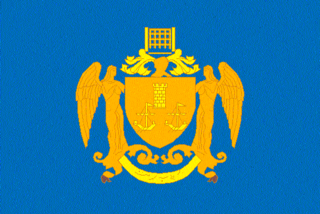
Khambhat state or Cambay state was a princely state in India during the British Raj. The city of Khambhat in present-day Gujarat was its capital. The state was bounded in the north by the Kaira district and in the south by the Gulf of Khambhat.
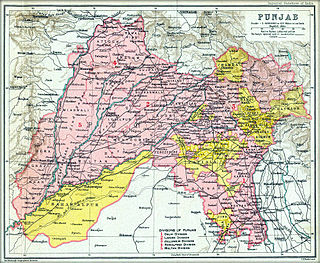
The State of Malerkotla or Maler Kotla was established by Maharaja of Parmar Rajputs, is a princely state in the Punjab region since the era of British India. Which was taken over by Sarwani and Lodi Pashtun dynasty from Afghanistan, and named Malerkotla as capital.
Loharu Fort, built in 16th century, is a state protected archaeological monument in Loharu town in Haryana state of India. Fort is part of interstate Shekhawati region which lies on the either side of Haryana-Rajasthan border in the sandy bagar tract.
